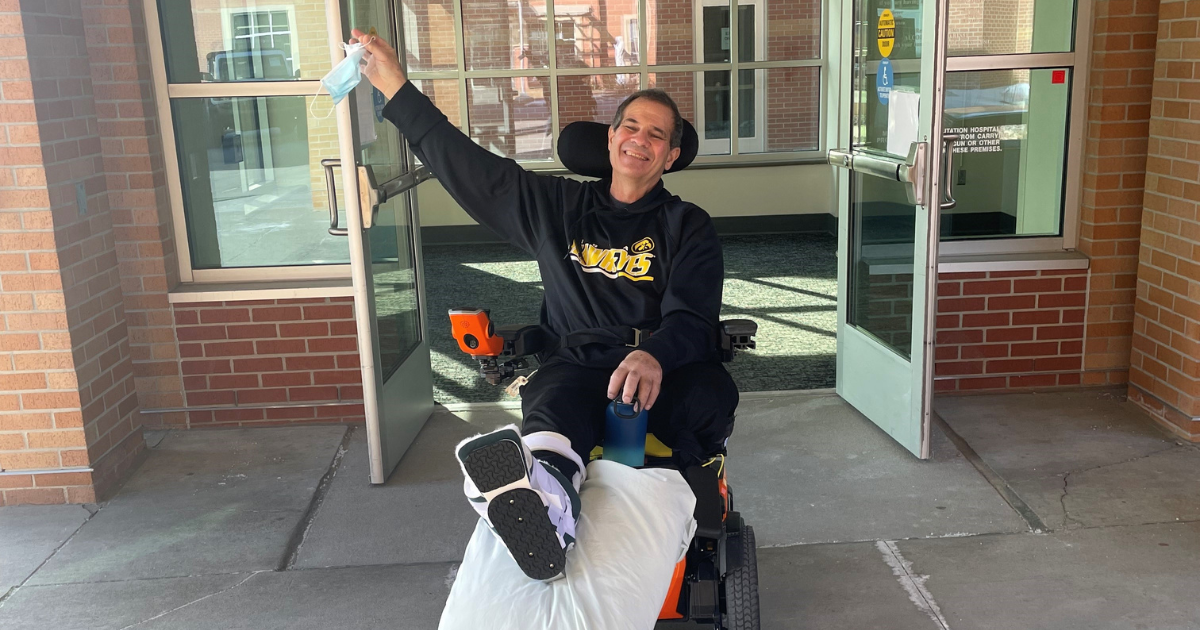Man undergoes targeted muscle reinnervation after train vs. truck crash

After a train hit 61-year-old Ladell Kellenberger, doctors were forced to amputate his leg. Thanks to targeted muscle reinnervation surgery, he’s had a smoother road to recovery.
If you ask the 280 people in Lester, Iowa, about Ladell Kellenberger, 61, they might not know who you’re talking about. That’s because he’s known by his nickname, “Gopher.” But everyone knows about Kellenberger’s accident.
As the youngest of 12 siblings, Kellenberger got his moniker from digging around in the dirt and getting messy. For the past 30 years, Kellenberger has operated a backhoe and worked as a part-owner for Leuthold’s Plumbing and Heating.
“At my job, I’m the dig man, and in the summer, I get dirty all the time,” Kellenberger says. “Sometimes you lose your nickname as you get older, but mine stuck.”
Nov. 8, 2021, was a very sunny day, and Kellenberger was taking his truck to a job site that morning. Today, he’s still unsure if the sun caused him not to see the train.
“I drove directly into the second locomotive, and I didn’t stop – I did not see the train,” Kellenberger recalls. “Thankfully, I don’t have nightmares about it because I didn't see it. It was a bad crash, and I was very lucky. There are miracles out there, and I’m one of them.”
It took almost an hour to get Kellenberger out of the truck. He was airlifted to a Sioux Falls, South Dakota, hospital and was in tremendous pain when he came to. His left leg was missing about 10 inches of artery, so the medical team had no choice but to amputate. He had a broken left elbow, and everything below his right knee was crushed.
Kellenberger was eventually transferred to Nebraska Medical Center, where plastic and reconstructive surgeon Kai Yang, MD, was one of three doctors involved in multiple surgeries.
“They airlifted me from Sioux Falls to Omaha, and from there, it was surgery, surgery, surgery,” says Kellberger. “I had three doctors working on my leg and elbow fractures, and Dr. Yang rerouted the nerves in my left leg where I had my amputation.”
Dr. Yang performed targeted muscle reinnervation or TMR, a surgical procedure that reconnects severed nerves after an amputation. If nerves are unconnected, they can cause severe or phantom pain for amputees. TMR is critical to patient recovery and can be done at the time of amputation or after.
Kellenberger had 18 screws in his left arm and skin grafts on his right leg. His right leg had bone exposed, and the wound was dirty, so Dr. Yang was concerned Kellenberger could get an infection.
“Everything was open and dirty, so I treated him for infection. He had a fever, but he never got an infection,” explains Dr. Yang.
Dr. Yang says Kellenberger’s right lower leg had an open fracture on the tibia. Bone cement filled the void temporarily, and the muscle and skin died around the lower leg. Dr. Yang explains he performed a free tissue transfer and moved the latissimus muscle from Kellenberger’s back to the right leg as a free flap to reconstruct and save the right leg. Skin was grafted on top of the free muscle flap to complete the construction.
“I thank Dr. Yang for the great job he did on my left leg. It helped me tremendously, and I have no phantom pain anymore,” says Kellenberger. “People say that’s a huge thing when they lose a limb.”
About 80% of patients experience post-amputation phantom limb pain. Nerves that are severed can no longer connect with the intended targets, which causes pain that interrupts recovery and daily life. TMR is often most effective preemptively before nerve pain begins.
Before the first of the year in 2022, Kellenberger moved to Madonna Rehabilitation Hospital in Omaha, Nebraska.
“All I had to work with was my right arm,” Kellenberger says. “My legs were still bad because of the skin grafts. My left arm was in a cast, and I couldn’t move it. I was bedridden for a while, but I started doing therapy.”
Kellenberger left Madonna in a wheelchair in February 2022 and, thanks to his therapy, learned to live at home. He could stand but couldn’t walk until July 2022, when he got his prosthesis. Since then, Kellenberger has been going to therapy and trying to get back to work.
Kellenberger attributes the prayers and the closeness of everyone in Lester to help him pull through, as well as the incredible work of the team of surgeons at Nebraska Medical Center.
Our team of nerve specialists helps patients get back to living their lives to the fullest. If you might benefit from TMR or regenerative peripheral nerve interface, call 800.922.0000, or visit NebraskaMed.com/Plastic-surgery/hand.






